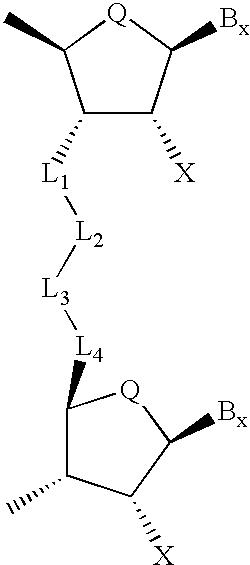Backbone modified oligonucleotide analogues
a technology of oligonucleotide and backbone, which is applied in the field of backbone modified oligonucleotide analogues, can solve the problems of less readily internalized modified oligonucleotides and oligonucleotide analogues, unlikely that unmodified oligonucleotides will be useful therapeutic agents, and generally suffer from inferior hybridization properties. , to achieve the effect of improving the pharmacokineti
- Summary
- Abstract
- Description
- Claims
- Application Information
AI Technical Summary
Benefits of technology
Problems solved by technology
Method used
Image
Examples
example 1
Synthesis of CPG-bound Nucleosides for methylene-hydrazine, i.e. (3'-CR.sub.2--NH--NH--CH.sub.2-5'), Linked Oligonucleoside
[0100] Diphenylimidazolidino Protected 5'-aldehydic thymidine
[0101] CPG-bound thymidine (30 micromoles of thymidine on one gram of CPG support, ABI, Foster City, Calif.) is treated at ambient temperature with a mixture of DMSO, benzene, DCC, pyridine, and trifluoroacetic acid (15 ml / 15 ml / 2.48 g / 0.4 ml / 0.2 ml in a procedure similar to the oxidation procedure of Pfitzer, K. E. and J. G. Moffatt, Journal of American Chemical Society 85:3027 (1963), to provide the 5'-aldehydic nucleoside. The mixture is filtered after storing overnight. The support is washed with oxalic acid (1.3 g in 5 ml benzene / DMSO, 1 to 1) and treated with 1,2-dianilinoethylene (3.0 g) for one hour, filtered, and washed with acetonitrile to afford the 5'-diphenylimidazolidino protected 5'-aldehydic thymidine.
[0102] 5'-Deoxy-5'-hydrazino-thymidine
[0103] Treatment of the support-bound 5'-aldehyd...
example 2
Synthesis of Uniform (3'-CH.sub.2--NH--NH--CH.sub.2-5'), i.e. methylenehydrazine, Linked Oligonucleosides on a DNA Synthesizer
[0106] CPG-bound thymidine with a diphenylimidazolidino protected 5'-aldehyde from Example 1 that will become the 3'-terminal nucleoside is placed in an Applied Biosystems, Inc. (ABI) column (250 mg, 10 micromoles of bound nucleoside) and attached to an ABI 380B automated DNA Synthesizer. The automated (computer controlled) steps of a cycle that are required to couple a desmethyl nucleoside unit to the growing chain are as follows.
1 STEP REAGENT OR SOLVENT MIXTURE TIME (min:sec) 1 3% DCA in dichloroethane 3:00 2 Dichloroethane wash 1:30 3 5'-Deoxy-5'-(1,3-diphenylimidazolidino)-3'-deoxy-3'-C-methylene hydrazine nucleoside (the second nucleoside); 20 micromoles in 30 ml of acetonitrile 2:50 4 Sodium borohydride (50 micromole in 1:1 THF / EtOH, 50 ml) 3:00 5 Dichloroethane wash 2:00 6 Recycle starting at step 1 (acid wash) 3:00
[0107] This procedure yields as its ...
example 3
Synthesis of 5'-deoxy-5'-hydrazino Nucleosides 5'-Deoxy-5'-hydrazinothymid-ine hydrochloride
[0109] To provide 5'-benzylcarbazyl-5'-deoxythymidine, 5'-O-tosyl-thymidine, [Nucleosides & Nucleotides 9:89 (1990)] (1.98 g, 5 mmol), benzylcarbazide (4.15 g, 25 mmol), activated molecular sieves (3A, 2 g), and anhydrous dimethylacetamide (100 ml) were stirred together with exclusion of moisture at 110.degree. C. (bath temperature) for 16 hours. The products were cooled and concentrated under reduced pressure (bath temperature <50.degree. C.). The residue was purified on a silica gel column (5.times.45 cm) with CH.sub.2Cl.sub.2 / MeOH (9:1, v / v) as the solvent. The homogeneous fractions were pooled, evaporated to dryness and the foam recrystallized from EtOH to yield 0.7 g (36%) of 5'-benzylcarbazyl-5'-deoxythymidine; mp 201.degree. C.; .sup.1H NMR (Me.sub.2SO-d.sub.6) .delta.1.79 (s, 3, CH.sub.3), 2.00-2.18 (m, 2, C.sub.2,CH.sub.2), 2.95 (t, 2, C.sub.5,CH.sub.2), 3.75 (m, 1, C.sub.4,H), 4.18 ...
PUM
| Property | Measurement | Unit |
|---|---|---|
| Temperature | aaaaa | aaaaa |
| Temperature | aaaaa | aaaaa |
| Temperature | aaaaa | aaaaa |
Abstract
Description
Claims
Application Information
 Login to View More
Login to View More - R&D
- Intellectual Property
- Life Sciences
- Materials
- Tech Scout
- Unparalleled Data Quality
- Higher Quality Content
- 60% Fewer Hallucinations
Browse by: Latest US Patents, China's latest patents, Technical Efficacy Thesaurus, Application Domain, Technology Topic, Popular Technical Reports.
© 2025 PatSnap. All rights reserved.Legal|Privacy policy|Modern Slavery Act Transparency Statement|Sitemap|About US| Contact US: help@patsnap.com



